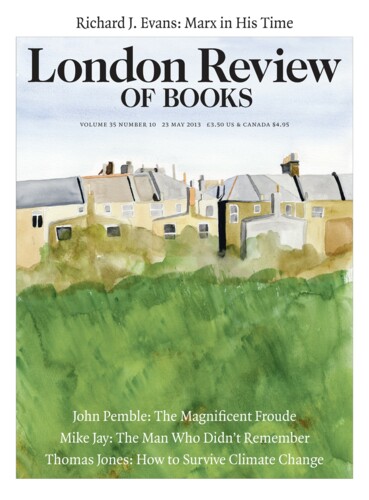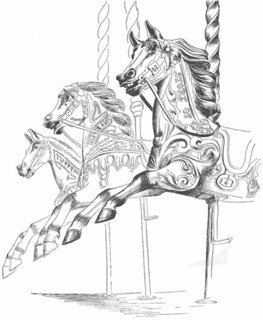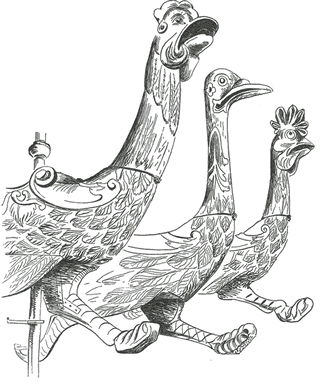The Festival of Britain in 1951 marked the centenary of the Great Exhibition. It came six years after the end of the Second World War and three before the end of rationing. By this time Barbara Jones was 39, an established artist and designer. The titles of the books and magazine articles that made her name as an illustrator tell their own story: a translation of Boulestin’s Ease and Endurance; Bombed Churches as War Memorials; and a piece for Vogue with the headline ‘Civilisation Is Still with Us’. Out of a combination of optimism and austerity a new postwar, post-imperial Britain was struggling to emerge. It was trying to find not only its feet but its face, a look, for objects and houses, that was modern and yet reassuringly continuous with tradition and history. Good design was seen as important for both morale and economic recovery. In 1946 the V&A put on Britain Can Make It, an exhibition which showed off the best of modern manufacturing and was widely known as ‘Britain Can’t Have It’, because most visitors had no chance of getting the things exhibited for their own homes. In 1948 and 1949 there was a more approachable touring exhibition, Design Fair, and then, on the south bank of the Thames, came the Festival of Britain.
Jones was involved in all of them. She designed a mural for Britain Can Make It and for Design Fair a set of panels on the theme of animal, vegetable and mineral. They were witty in the romantic surrealist vein of Paul Nash and Tristram Hillier, depicting sets of shelves and glass cases in otherwise bare landscapes with natural and manmade objects displayed on them to make puns on similar shapes: coral and a hatstand, a lyre and a lyrebird, a soldier’s helmet and a turtle. Her contributions to the Festival of Britain included The Coastline of Britain, a mural in which she decided to incorporate a giant Victorian-style sand picture six feet long. It turned out, she said, to be ‘like painting the Mona Lisa by numbers’. Her other Festival project, an exhibition of ‘British Popular and Traditional Art’ at the Whitechapel Gallery, proved even more difficult. That show, which she called Black Eyes and Lemonade, a quotation from Thomas Moore, is now back in a different form at the Whitechapel, as the subject of its own exhibition (until 1 September).
The problem was one of definition. The organisation of Black Eyes and Lemonade was shared with the Society for Education in the Arts (SEA), which had firm ideas about popular tradition. These mostly revolved around ‘smocking and Staffordshire dogs’, Jones recalled. She on the other hand wanted to bring popular art up to date. Her list of exhibits included manufactured objects – plaster, plastic, advertising posters and ‘a fine 1951 fireplace in the shape of an Airedale dog’. The SEA was not amused – this was not the face they wanted to put on the new Britain – but the Whitechapel backed her. A note by the then director, Hugh Scrutton, dismisses the objections as the product of a ‘William Morris creed … unrealistic, romantic and naive’. The present exhibition omits to mention that the Whitechapel had itself been an expression of Arts and Crafts ideals, promoted by Morris’s friend Henrietta Barnett, who wanted to bring art to the East End with the Ruskinian motto ‘Life without industry is guilt, industry without art is brutality.’ By 1951, however, the gallery’s ideas had changed as popular art and indeed people had changed. It won the battle.
The display was thematic and ‘eased’ visitors in, as Jones put it, with some carved figureheads and other familiar examples of folk art. As they went on they found ‘the new and commonplace’ alongside ‘the old and safe’ until, she noted with satisfaction, ‘by the end most people felt able to accept a talking lemon extolling Idris lemon squash and Bassett’s Liquorice Allsorts isolated under a spotlight.’ Her definition of popular art, if incomplete, was acute. The fine arts, she wrote, ‘express the artist’s mind and eye, the sole aim of popular art is to please the consumer’. She saw it as her role to be ‘investigative rather than didactic’, as the catalogue notes. Arranged under headings which included ‘sweets’, ‘transport’, ‘cinema’, ‘stationery’ and ‘death’, Black Eyes and Lemonade explored its subject, played with it and set it out as a genial argument. Visitor numbers passed the expected twenty thousand to reach 30,754 and most people liked it, although the Whitechapel synagogue complained that a waxwork of the late chief rabbi was sited disrespectfully close to the talking lemon. The rabbi duly changed places with a model of Queen Anne.
Press coverage was also, for the most part, enthusiastic. The Evening News was amused, recommending anybody who happened to have 3862½ matchsticks to go along and see how they could be made into a model of Dunstable parish church. Everybody’s London was uncertain but concluded that ‘art or not, this is an exhibition that is unmistakeably British.’ The loudest dissenting notes were struck by the left and the modernists, who showed themselves to be the intellectual heirs of the didactic Victorian tradition. John Berger, in the New Statesman, complained that the show demonstrated that ‘industrial capitalism has now destroyed the standards of Popular Taste and substituted for them standards of gentility, Bogus-Originality and competitive cultural smartness.’ ‘The local inhabitants of Whitechapel’, he said, had no interest in the exhibits. In fact it was the gallery’s most popular exhibition of the decade.
The surviving fragments assembled here inevitably look somewhat forlorn. The dog made out of old Senior Service cigarette packets, the tin toys and faded fireworks have themselves passed into history. The Airedale fireplace seems frail. But the exhibition shows not only where Black Eyes and Lemonade came from, it suggests where it led. One of the less eye-catching but significant items is Jones’s appointment diary for 1950. On Friday, 15 September she noted ‘Eduardo Pallozi [sic] 6.30’. Paolozzi’s lecture at the ICA in 1952, illustrated with cinema stills and advertisements, came to be seen as a significant early moment in pop art. Peter Blake, 19 and just out of art school, also visited the Whitechapel and took note. Advertising, tattoos, commercial lettering, a lot of Black Eyes and Lemonade passed rapidly from popular art into pop art by way of Jones’s daring, humorous and too little celebrated exploration of the modern material world.
Send Letters To:
The Editor
London Review of Books,
28 Little Russell Street
London, WC1A 2HN
letters@lrb.co.uk
Please include name, address, and a telephone number.



